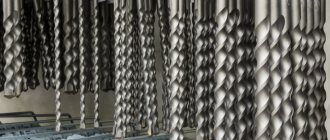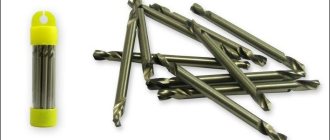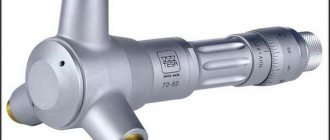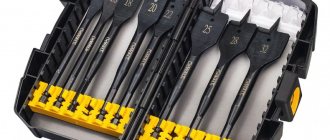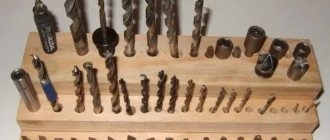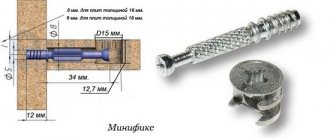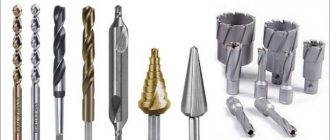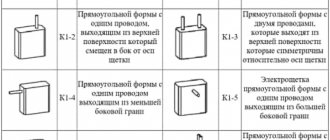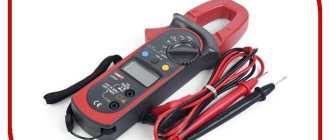Changed and forgot | 08.12.2019
When performing complex work on machining parts, it is often necessary to combine several transitions, for example, milling with drilling. Some manufacturers of household power tools (for example, DeWalt, Sandvik, etc.) solve this problem by simply adding a number of bits to the standard tool set. However, it is possible to carry out processing using a combined method - a drill-cutter tool, saving time and without compromising the quality of the final result.
Overview of species
The classification of drill bits and cutters for wood is largely determined by their shape and method of fastening in the tool. Let's look at the main varieties found on sale.
- Flat milling. A product with a wide, flattened cutting element allows you to work with large diameter holes.
- Cylindrical. Resembles the appearance of classic drills, the milling part has the same diameter as the tip.
- Nasadnoe. This version of the drill bit is used as a tool for a milling machine. Its tip is oriented for installation in a spindle and has a standard seat diameter of 32 mm.
- Terminal. This option is also called finger. Its landing part is quite thin, simple, and has a diameter of 8-12 mm. End drill bits are also called universal because they can be attached to both special machines and ordinary hand tools.
- With a two-feather blade. With this tool you can chamfer, mill and drill soft non-ferrous metals. The optimal tilt angle for it is from 60 to 120 degrees. To improve performance characteristics, titanium boride coating is applied to the product.
- With a four-blade type. A drilling and milling tool of this type increases the diameter of the holes made and helps increase the number of grooves formed. This option is used for processing hard metals.
This is the main classification. In addition, cutter drills can be carbide - they are most often used for metal work, and also made of high-speed tool steel. The shank of end products is cylindrical and hexagonal. It can have different lengths.
The classification also includes the type of surface being processed. Universal varieties are suitable for working with different surfaces.
There are also specialized options for metal and wood. Based on the manufacturing method, we can distinguish between composite and solid cutters.
Varieties
Depending on the processing conditions, the combined milling drill can be manufactured in the following versions:
- With a two-feather blade. This tool is designed for chamfering, milling, and drilling non-ferrous metals. For drilling, the pen angle must exceed 60°. This rule is general for all drill bits, but the optimal inclination angles should be 60°, 82°, 90°, 100° and 120°. Tools with increased operational resistance are subjected to titanium-boride sputtering or titanium-nitride-aluminum coating.
- With a four-blade (for milling). Provides two grooves going to the center, and two grooves that are cut off. This drilling end mill is designed for the same operations as the previous one, but has an increased diameter, which allows you to increase the number of grooves. As a result, the tool gains increased strength and allows you to process harder materials. Additional grooves create more contact points during machining, resulting in improved surface quality. Surface hardening treatment is the same as in the previous version.
- Double-flute drill-mill. The tool is suitable for operations such as milling, drilling and chamfering, but only for materials with good machinability. Optimal tilt angles are 90°, 120° and 140°, surface coating is titanium-aluminum-nitride.
- Drilling end mill with helical tip. Provides best performance for chamfering, milling and fine boring. The spiral tip design ensures complete chip removal and high surface finish. At the same time, vibrations are reduced and the alignment of the resulting part is maintained. Tilt angles - 60°, 90° and 120°, surface coating - titanium and aluminum nitrides.
High-speed tool steels of type R6M5K9 according to GOST 19265-84, which are characterized by high strength and good heat dissipation, are used as the material for the manufacture of cutter drills. If it is necessary to mechanically process high-hardness steels with the described tool, you should focus on automatic steel grades from A12 and higher, containing lead, about 0.3% sulfur and no more than 0.15% phosphorus. The grades of such steels can be selected according to GOST 1414-75.
Milling cutters for the device: types, purpose, how to choose and use in manicure and pedicure
It is difficult for a novice master to understand the hundreds of types of cutters offered to complete the equipment. It’s convenient when the machine comes with a good starter kit, and all that remains is to test the attachments and purchase what you need in the process of further work.
But how can a beginner who is creating his own toolkit “from scratch” figure it out? Let's look in detail at what cutters are needed for hardware manicure and pedicure, how to work with them, which manufacturers are on the market and what criteria to use to choose attachments. Let's get started!
Drill-mill. Two in one!
When performing complex work on machining parts, it is often necessary to combine several transitions, for example, milling with drilling. Some manufacturers of household power tools (for example, DeWalt, Sandvik, etc.) solve this problem by simply adding a number of bits to the standard tool set. However, it is possible to carry out processing using a combined method - a drill-cutter tool, saving time and without compromising the quality of the final result.
Technological capabilities of the drill-cutter
The tool looks like a regular end mill. At the same time, it seems possible to perform the following transitions from one installation:
- Making V-grooves.
- Drilling.
- Milling.
- Obtaining chamfers.
This possibility is ensured by the presence of two working planes - side and end, the profile of which is determined by the material being worked with (there are combined drill-cutters for metal and wood). True, the metal should not be heat-treated, and the wood should not be too hard.
As you know, the significant difference between a drill and a cutter is the geometry of the tool’s contact points with the workpiece. When milling, an S-shaped gap is always observed at the end, while when drilling it is possible only on the generatrix of the working part. Accordingly, the strength and elasticity of different zones of the tool are also different.
The milling drill optimally combines the helical geometry of the side cutting edges with a variable helix pitch along the length of the tool. This increases productivity and allows material removal operations to be performed in one pass.
All about drill bits
- Peculiarities
- Overview of species
- Selection rules
A drill-mill is a universal solution for simultaneous drilling and processing of metal, wood, and other materials with low hardness values. Using such a tool, you can not only make holes, but also expand them using the side edge. Tips on choosing a milling drill for metal, wood, as well as other options for materials and products for various purposes will help you learn more about it.
Peculiarities
Combination cutting tools are becoming increasingly popular. The drill-cutter belongs specifically to this group of products; it simplifies and reduces the number of operations when processing materials. Each of them has 2 elements: drilling and milling. The first part is necessary to create a hole of the required depth and diameter. The cutter is located on the side edge; if necessary, it can be used without changing the tool - by changing the pitch of the spiral along the length, it is possible to obtain the desired result in 1 pass.
The distinctive characteristics of such a tool include high wear resistance and long service life. They are made from hard steel that is not subject to intense wear. In addition, such a tool can be resharpened. If the corner part of the drill becomes dull, its sharpness can always be restored.
Among the technological capabilities of such products, one can highlight the performance of a whole range of operations. In addition to conventional drilling, this can include V-grooving, chamfering and milling.
These drills are versatile. They are suitable for use with a wide range of materials:
- plastic;
- MDF;
- chipboard;
- plywood;
- drywall;
- solid natural wood;
- metal.
It is important to consider that the successful operation of a combined tool is determined by its correct use. It works best when working with heat-treated metal and soft wood.
The design of the milling drill includes a shank for securing an electric or manual tool in a chuck. There are also 2 work surfaces at once, which can be used sequentially or individually. Such combined models are most in demand in the field of woodworking. Depending on the type and diameter of the landing part, cutter drills can be universal, for machine tools and hand tools, or specialized.
To increase the strength of steel tools, increase their service life, and reduce friction when performing work, their surface is often coated with special compounds. The most common items are golden in color. They are coated with titanium nitride. Drill-cutters are sold not only individually, but also in sets - it is advisable to purchase such a set if drilling is done frequently or is put on stream.
Material
Based on material, hardware cutters are divided into the following types:
- Carbide (metal)
- Ceramic
- Diamond
- Corundum
- Sand or silicon carbide copings
- Grinding - made of rubber, silicone, suede
Carbide
They work on the principle of a knife. The more pronounced the notches, the deeper the metal penetrates into the extended material or skin.
Ceramic
Made of ceramic, they also have notches on the surface. They are fragile, cracks and chips form when impacted, so they require more careful handling when working.
Diamond
Corundum
They are characterized by high resistance to high temperatures and heating during operation.
Silicon carbide or sand copings
Used for pedicures to treat rough skin and corns. They have a cardboard base with spraying. Disposable. The caps are placed on a rubber base, which is sterilized after use, and the nozzles themselves are disposed of.
Grinding
Depending on the base material - rubber, silicone or fabric, they make it possible to polish areas of different sensitivity in manicure and pedicure. They can also be used in tandem with oil or polishing cream if additional skin nutrition is needed. This is often true when treating feet in a pedicure.
Selection rules
You can select suitable drill bits for use if you take into account all the important points.
- Country of manufacture and brand. Inexpensive products from China do not always live up to the expectations placed on them - they quickly become dull, break, and bend. More reliable options are produced by companies from the USA, Germany, and Russia. Among the market leaders are Metabo, Hawera, Ruko.
- Material of manufacture, presence of coating. For metal work, options made of carbide steel are used, the most durable and productive, with or without coating. Other drills are more suitable for processing wood and composite materials, chipboard and fiberboard. They are made from high-speed tool steel.
- Tail type. It directly determines the compatibility of the tool. For drills and hammer drills, options with a hexagonal or cylindrical tip are best suited. In addition, the length of this part is important. It must correspond to the parameters of the hand and power tools on which the attachment will be installed.
- Dimensions. The diameter of the drill bit is indicated by the manufacturer in millimeters. This parameter is always determined by the dimensions of the working part.
- Type of milling element. It determines which holes can be obtained after processing. The angle of sharpening is also important.
All these factors help to select high-quality and reliable drill bits for working on metal or wood. Combination instruments help to simplify and reduce the number of operations, eliminating the need to change the tip. By refusing to change bits and choosing the right combination product, you can get a result no worse than when performing work using special milling equipment.
The following video talks about drill bits.
What is the difference between a milling cutter and a drill?
METALWORKING EQUIPMENT No. 12 (57) 2008
HOLE MACHINING – DRILLING OR MILLING?
At the present stage of development of the design of CNC machines, cutting tools, the use of new wear-resistant coatings and processing methods, new opportunities are opening up that allow the most complete and effective use of metal-cutting tools in the manufacture of various products.
Often, when processing parts on milling machines, it is necessary to make holes of various diameters, the main method of producing which is drilling. This type of processing requires a wide range of cutting and auxiliary tools, since each drill is designed to produce holes of a certain diameter.
An alternative to drilling when processing shallow holes is the milling method with helical interpolation (Fig. 1), where the formation of a hole occurs by combining the axial movement of the tool with the spiral movement of its axis.
This method is more universal and allows processing holes of various diameters, stepped holes and, often, depending on the requirements of the drawing, can replace the boring operation. All of the above, in turn, leads to a reduction in the range of tools used and a reduction in the total processing time of the part.
An example of the use of the helical interpolation method is a series of cutters from DIJET (Japan), specially designed for processing aluminum (Fig. 2), which allows, if this function is available in the machine control system, to mill holes with a depth of up to 3 diameters in the range from 5 to 32 mm.
The original geometry and sharpening shape of the cutting part of the cutter ensure high strength of the cutting edges and effective removal of chips from the cutting zone. Specially developed carbide grade JC20015 DLS in combination with a new diamond wear-resistant coating significantly increases productivity and tool life, and also reduces the possibility of build-up on the cutting edges during cutter operation. In Fig. Figure 4 shows a DIJET cutter with a new wear-resistant coating and improved geometry of the cutting part in comparison with a classic cutter (Fig. 3) for processing aluminum.
As a technological example, let us consider the processing of a part made of an aluminum alloy, which has three holes on the same plane 30 mm deep with diameters of 10, 12.5 and 15 mm.
We present the obtained data in the form of a table (Table 1).
Having analyzed the results obtained, we can conclude that in order to process holes using the drilling method, it is necessary to have three drills of the appropriate diameter, three sets of auxiliary tools and the presence of three free slots in the tool magazine of the machine. Hole processing with this method is carried out with each tool separately, followed by a tool change at the end of each cycle.
Processing of holes using the milling method with helical interpolation is carried out with one cutter, does not require changing tools and, in some cases, is the most appropriate and cost-effective. The range of cutting and auxiliary tools used is reduced, and the total processing time of the part is reduced (time reduction by 8.2 seconds, which is 44% compared to drilling). As a result, the costs of purchasing expensive tools and manufacturing the part as a whole are reduced.
A complex characteristic of a tool used for processing on CNC machines is its dimensional stability, which ensures a full cycle of processing one or more parts within the established tolerance range.
Comparative tests of cutters carried out in production conditions showed that the roughness (Fig. 5) and geometry (Fig. 6) of the resulting surface with a sufficiently rigid AIDS system remain unchanged for a long time.
When assigning cutting modes for processing parts using the helical interpolation method, it is necessary to take into account not only the material and condition of the workpieces, the type of equipment and the rigidity of the AIDS system, but also adhere to the recommended values for the tool diameter (Fig. 7) and the helical interpolation pitch.
The helical interpolation step is determined based on the diameter of the tool path. Recommended interpolation depth values are presented in table. 2.
In conclusion, I would like to note that the method of producing holes by milling with helical interpolation creates serious competition with drilling when processing body parts. The ability to produce holes for various purposes with different characteristics makes it more versatile in use. Reducing the range of cutting and auxiliary tools, reducing the total processing time significantly increases the productivity of the technological process and reduces the cost of manufacturing parts.
© ST Group 2004 — 2022 — All rights reserved
Full or partial copying of materials, only indicating the source link, https://st-group.com
Tel/fax, E-mail
